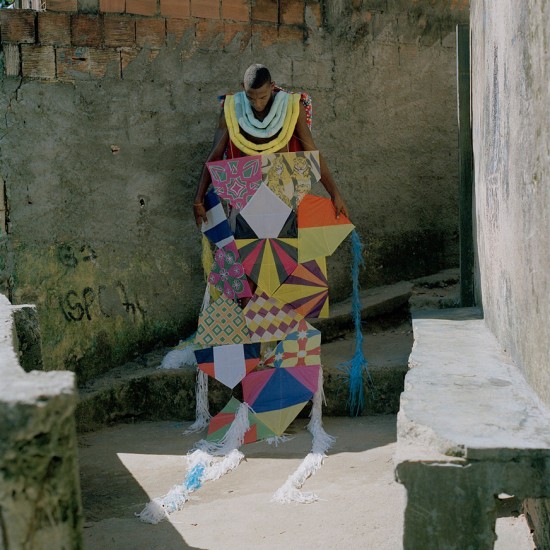There is a lot going on in American artist Stephanie Gervais’s exhibition O Lider Invisivel (the invisible leader), showing this month at Les Territories. The performance, photo and video works, created with members of Rio di Janeiro’s Rocinha favela, propose to empower favela Brazilians infantilized by state power and marginalized by mainstream society. The unfortunate undercurrent of these pieces, which results in illogically executed ideas, are the misplaced good intentions of a western artist with an impulse to liberate the oppressed.
Gervais’ ‘living statues’ are photographic interruptions of staged performances: costumed men attempt to pay tribute to the spirit of favela culture by combining the honorific characteristics of statues with the ephemeral nature of their community. The artist presents four portraits of men standing in outdoor Rocinha locations, swathed in brightly colored, makeshift garments whose gaudy aesthetic of plastic tassels, kites, flowers, string, and beads is a distorted sartorial echo of carnival culture. Based upon such a thin premise, Gervais’s choice to use live Brazilians as her art objects creates an awkward set of caricatures.
Seeking to avoid the prejudice that naturally falls on people from favelas, ‘body posters’ veil the body with a poster bearing a transcription of their opinions regarding the void left after the police drove out the drug dealers who acted as community leaders. In these portraits, favela Brazilians wearing face covering headdresses of tiny, multicolored beads hold out big white posters inscribed with quotes of things they have said. This attempt to valorize an oral culture by inserting it into a hierarchy that privileges the written word reinforces the set structure rather than challenging it.
In all her images, breathtaking natural landscapes contrast with the cement constructions of the favelas. Concrete streets, patios and houses are framed by palm trees, lush green mountains and distant, cloud-wrapped peaks.
Across the room is a looped, single channel video of these photography sessions that pans slowly over the surrounding landscape. A segment of a man, fully costumed, dancing to tinny music in a bare, cement room is followed by up-close footage of people wrapped in body posters.
Gervais’ project is ambitious, but it falls way short of adequately tackling her themes of self-governance, language and empowerment. The ‘body posters’ meant to empower the speakers literally disembody them. Sure, their speech may gain consequence by being written, but if talker’s bodies are hidden by these words, are they not being obliterated rather than liberated? Though the handmade costumes the favela Brazilians wear as ‘living statues’ first appear to stage an authentic, revalorizing identity, what simply and maybe too obviously occurs when the artist uses these images in a north American exhibition, is a nearly farcical objectification of her Brazilian subjects. One is left with the impression that these works would be much more interesting if, instead of the concerns of a community of people, Gervais had used her own impressions as a starting point.
Les Territoires, space 527
Stephanie Gervais
O Lider Invisivel
August 10 – September 1st, 2012
http://lesterritoires.org



